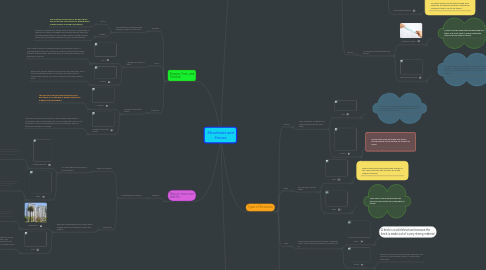
1. Purpose, Form, and Function
1.1. Purpose
1.1.1. The reasoning of why we need a specific object or structure
1.1.1.1. Pencil
1.1.1.1.1. We need pencils because if we don't have pencils we can not correct our writing when editing a piece or doing calculations.
1.1.1.2. Google
1.1.1.2.1. Used as a research tool which gives us access to other links so that we can search up needed information without having to search through books. It also creates enquiry-based learning, when we ask ourselves questions to learn something new.
1.2. Form
1.2.1. The way an object is built
1.2.1.1. Car
1.2.1.1.1. Built using a network of different parts, including an engine, a fuel tank (unless the car is electrical, in which case it would need a battery) sttering wheel, and other parts to control the speed, and direction of the car.
1.2.1.2. House
1.2.1.2.1. Built using wooden supports to hold up floors and walls, and a strong foundation made of concrete, and other factors support the stability of it, houses serve its function using its form
1.3. Function
1.3.1. The way a structure works
1.3.1.1. Bicycle
1.3.1.1.1. The bicycle is built to travel to places if you don't have a car, the way is works is that it has a wheel so it has mobility.
1.3.1.2. Portable Hard Disk Drives
1.3.1.2.1. Used to store backup information, these devices help when a computer's space is extremely low. You can plug this in like a USB and then access it from the library on your computer, and can have info uploaded or deleted.
2. Types of Forces
2.1. External Force
2.1.1. A force acting on the outside of an object or structure
2.1.1.1. Static Load
2.1.1.1.1. A type of load that is affected by gravity
2.1.1.2. Dynamic Load
2.1.1.2.1. Any force acting on an object or structure other than gravity
2.2. Internal Force
2.2.1. A force created when an object acts on itself
2.2.1.1. Compression
2.2.1.1.1. When an object is under pressure
2.2.1.2. Shear
2.2.1.2.1. An internal force that is a ripping or bending motion
2.2.1.3. Tension
2.2.1.3.1. When an object that is stretched
2.2.1.4. Torsion
2.2.1.4.1. An internal force that twists an object
3. Types of Structures
3.1. Frame
3.1.1. Uses a network or skeleton of materials that support each other
3.1.1.1. Car
3.1.1.1.1. A car is a type of frame because when the car is pieced together, it is made out of many parts and supporting materials
3.1.1.2. Phone
3.1.1.2.1. Phones have many parts and also have a strong support on the outside, to protect its inside
3.2. Shell
3.2.1. Has a hollow, curved shape
3.2.1.1. Egg
3.2.1.1.1. Egg is a shell structure because the outside of the egg is the shell that protects the inside, where it is hollow
3.2.1.2. Igloo
3.2.1.2.1. Igloo have a strong outside that can hold and can protect the inside which is hollow
3.3. Solid
3.3.1. Uses strong construction materials to support loads. It may have small spaces or no space at all.
3.3.1.1. Brick
3.3.1.1.1. A brick is a solid structure because the brick is made out of a very strong material
3.3.1.2. Wood
3.3.1.2.1. Wood is solid because it has barely any gaps, and is a full on solid mateial useful to create other structures.
3.4. Combination
3.4.1. Is made up of 2 or more of the types of structures
3.4.1.1. House
3.4.1.1.1. houses are combination structures because a house is a frame structure, solid structure and a shell structure
3.4.1.2. Computer desk
3.4.1.2.1. The computer desk is a solid structure and a frame structure, so it is made of 2 types of structures
4. How to apply force
4.1. Magnitude
4.1.1. The amount of speed or strength applied to a structure
4.1.1.1. Wrecking ball
4.1.1.1.1. Wrecking ball is a magnitude because when you use a wrecking ball, you can apply the amount of speed or the amount of power going to be applied on a structure
4.1.1.2. Bowling Ball
4.1.1.2.1. Bowling ball describes magnitude because when you roll it, your spped determines how hard and far your ball will go to hit a few pins or all.
4.2. Direction
4.2.1. Whether a force is a push or a pull
4.2.1.1. Moving a chair
4.2.1.1.1. When you move a chair, the chair can be pushed or pulled, pushing meaning travelling forward, and pulling meaning travelling towards you
4.2.1.2. Opening a door
4.2.1.2.1. Doors are built in different ways on how to open them. Other than the sliding ones and the high-tech ones, it is always a simple push or pull, so direction is needed.
4.3. Point of Application
4.3.1. The location where the force is applied
4.3.1.1. Pushing someone
4.3.1.1.1. When a person pushes someone, determing on the amount of damage, the pusher has to decide where they are going to affect them.
4.3.1.2. Hammering a nail
4.3.1.2.1. The applier of the force has to know to hit it it the middle of the head if it has to be efficiently applied, so the point is important
4.4. Plane of Application
4.4.1. Imaginary flat surface where force passes through(angle)
4.4.1.1. Wrecking Ball
4.4.1.1.1. They are positioned at a right angle from the wall, hitting it at 90 degrees so the angle of where it passes makes a difference.
4.4.1.2. Breaking an object
4.4.1.2.1. The angle of impact determines the amount of force applied, because different angles create different forces, though 90 degrees is the most common of all.
5. Ways to have more stability
5.1. Stability
5.1.1. How stable an object is
5.1.1.1. Centre of Gravity
5.1.1.1.1. Location where most mass is concentrated
5.1.1.2. Symmetry
5.1.1.2.1. Equal and congruent parts on each side if divided up by a line across or down the middle

